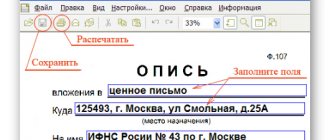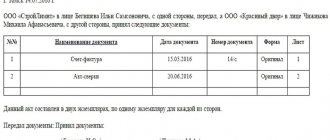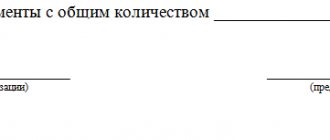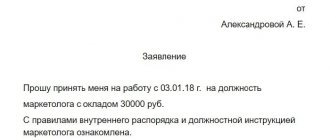The change of user of the property must be recorded on paper. Sufficient documentary evidence will be the act of acceptance and transfer of material assets, a sample of which we will provide below. We will also consider the cases for which it is relevant, the specifics of its application, the features of its preparation, mandatory details - all the important points so that you know how to fill it out correctly.
general information
Any company has some assets, and it is important not only to reliably protect them, but also to operate them effectively. To do this, they should be clearly controlled, transferred for temporary possession to other legal entities (without changing ownership), if this is economically beneficial, and this fact should be reflected in the accompanying documentation of the enterprise.
Please note that the legislation does not require the use of any one standard form. Any organization has the right to develop its own, convenient for employees and, in principle, simple sample of an acceptance certificate for goods and materials (inventory assets) - the main thing is that the form contains all the required details, a full list of which we will provide below. If you don’t have time for this, you can do it even more logically and fill out the MX-1 form, because it has several advantages:
- traditional for document management practice and therefore familiar to representatives of various authorities;
- unified and therefore understandable;
- convenient for adjustments - it’s not a problem to add the necessary data to it or delete unnecessary ones.
In practice, this is what most companies prefer, so it can be considered a standard. Just remember that it must be certified in any case so that it complies with the accounting policies of the enterprise.
General information about the document
The act is signed when the employer transfers spare parts, equipment, tools and other items to the employee to perform his duties, for example, when working on the road or at home. The employee undertakes to return the property upon completion of work.
The act can act as a primary accounting document. Based on it, the accountant will make notes in the company’s accounting about the movement of fixed assets between warehouses or employees. In this case, it is necessary to provide the document with all the necessary details for this (Part 2 of Article 9 of the Federal Law No. 402-FZ of December 6, 2011). From the contents of the act it should be clear who is transferring and who is accepting the objects, what values they are and in what quantities. Signatures of the employer and employee are required.
For your information! The document should not be confused with the act of acceptance and transfer of goods and materials for storage - its form is MX-1. It is used to transfer valuables for safekeeping to another organization. To transfer inventory items from one materially responsible person to another, use the OP-18 form or one developed on its basis.
Why is an act of transfer of material assets required?
It is proof of the fact of a change in the user of the property. Its error-free execution implies that the responsibility for the safety of the asset will be borne by the recipient, who will have to pay compensation in the event of loss or damage. With his name on hand, you can safely go to court with a statement of claim to recover the appropriate amount from the guilty party.
The one who gives something for a while is considered a depositor, the one who receives is considered a custodian. Information about these legal entities is necessarily written down in the business paper, along with the period and terms of the agreement. Immediately after the expiration of the agreed period, another document is created - indicating the return of the property.
When performing external operations, it is drawn up as an annex to the concluded business agreement. It also helps to record the fact of the direction of an asset from one structural division of the company to another, as a result of which the control of transferred objects is simplified (especially when branches are geographically remote from the head office and administrations). This approach allows you not to travel for business papers and not to carry them with you, but to use those that are locally available.
When is it necessary to draw up a transfer and acceptance certificate?
It is especially important to draw up an act in controversial situations when the recipient of the cargo has claims regarding the quantity and quality of items or raw materials received. This document records everything, including the presence of minor defects on individual copies of the product. So, this is the evidentiary basis that the sender sent a quality or defective product. This document must be reviewed by forensic experts in cases where a case is filed against one of the parties. It often influences the judge's decision in such matters.
Few people know that some types of cargo are transported only with this document. This mandatory condition is imposed on him by law. So, it is necessary when transporting high-tech devices or equipment. This requirement is due to the fact that equipment of this kind must be previously checked before shipment. In these cases, strict product quality control is carried out.
The document is also required to be drawn up when the goods are sent for storage. In this case, it is needed to provide written certification of the condition of the cargo at the time of its dispatch. It also indicates the storage conditions appropriate for the product. The document also contains the personal data of the person responsible for the safety of the transferred items.
Application of the act of acceptance and transfer of inventory items
Here are the most common cases of relevance of its design:
- During the inspection, a discrepancy in the quality/quantity of available goods was recorded;
- products are sent for storage;
- products arrive without accompanying documents;
- property is transported from one structural unit to another or redistributed between authorized persons;
- assets are alienated for someone else's benefit by decision of the commission;
- a contract is concluded for short-term use, for a period of several days or even hours.
In all of the above situations, it is permissible to fill out the business paper in question arbitrarily (by entering the necessary details).
Do you want to implement “Store 15”? Get all the necessary information from a specialist.
Thank you!
Thank you, your application has been accepted.
What is he like?
The simplest act of acceptance and transfer of goods and materials (inventory), the form of which we will separately provide below, is precisely the primary accounting documentation. Therefore, it must contain a detailed description and key distinctive characteristics of those things that become the objects of the transaction:
- purchase and sale;
- deliveries, one-time or regular;
- registration of a lease agreement (relevant not only for real estate);
- responsible storage.
The property described by this paper includes goods, raw materials for the manufacture of products, auxiliary materials such as additives or dyes, spare parts, semi-finished products, containers, and fuel. The main thing is that the work of the enterprise is simplified.
When is it compiled?
Whatever sample form for the act of acceptance and transfer of material assets you choose, remember that it should be drawn up, checked, and signed directly on the day the user of the property changes. This is usually done by the recipient or his authorized representatives: they indicate a specific date for the actual completion of the transaction.
In practice, control over the correct filling and approval is most often carried out by the head of the enterprise. He also determines which of his subordinates will be responsible for storing and ensuring the safety of the asset, as well as what compensation will have to be compensated in the event of damage, theft, or loss of the agreed items.
Briefly about the agreement
Work under a contract is regulated by Art. 702-729 Civil Code of the Russian Federation. The contract specifies all information regarding the work:
- what work will be performed;
- what materials will be provided by the customer;
- timing and method of transfer of materials;
- turnaround time;
- the obligation of the performer to return unused materials and more.
In addition to the contract, the following documents are also drawn up:
- act of acceptance and transfer of materials or equipment;
- invoice for the release of materials to the third party (according to form M-15 or a self-developed one);
- receipt order according to the recommended form M-4 - it is drawn up by the contractor after he receives the materials (if the raw materials need to be distributed among warehouse premises and several performers);
- certificate of completed work - also filled out by the contractor after completing the work.
For your information! This list can be shortened or expanded by agreement of the parties.
How to draw up an act of acceptance and transfer of material assets
Keeping in mind two things: firstly, that there is no single form of registration, which means there is a certain freedom in decision-making, and secondly, that there are still mandatory details, without which the document will not be have legal force.
Taking into account both of these points, we propose to act according to the following algorithm:
- Take MX-1 as a basis - understandable, standard and already containing fields for indicating the necessary information.
- You add data that is relevant specifically to your transaction, for example, evidence of product quality, an addition to the contract, the exact number of pieces in the shipment, existing complaints, etc.
- Remove unnecessary (outdated) information.
With this approach, you get the most concise and easy-to-check primary documentation.
Basic rules for drawing up a water act for operation
This document does not have a unified, mandatory form, so it can be compiled either in free form or according to a template developed and approved within the enterprise. The act can be written on a regular A4 sheet, or on the organization’s letterhead.
It must necessarily include information about the enterprise where the equipment is being put into operation, as well as detailed information about its name, technical characteristics, conditions of use, etc. The more complex the equipment, the more detailed information about it needs to be recorded and the more points the act may contain.
This document must indicate the compliance of the introduced equipment with the internal requirements of the organization and legal standards, and also record the presence of comments or identified malfunctions. If the facts of defects are confirmed, then a special defect report must be drawn up for the equipment and the equipment cannot be put into operation until the defects are eliminated.
It should be remembered that after signing the act of putting the equipment into operation, the manufacturer’s warranty begins to apply to it.
What is contained in the act
First of all, the mandatory details that have already been repeatedly mentioned, and secondly, important details that are relevant for a particular case, for example, about existing defects or the rental period. It is simply necessary to provide a place (point) for indicating claims - so that later there will be somewhere to enter your demands for compensation for damage suffered. If the subject of the transaction is not one object, but a whole group of them, different in type, value, character, this fact also needs to be reflected.
It should be filled out in at least 2 copies - for each party, so that there is an opportunity to subsequently go to court and resolve the controversial issue in their favor.
What form of the act of acceptance and transfer of material assets should be used?
It is not mandatory, but there are standard ones, that is, the most common and universal ones - we will consider them below.
MX-1: features of its filling
It looks like this:
Pay attention to the number and location of fields - they are designed so that you can clearly present all the important data. And the law does not prohibit removing some of them or adapting them to your needs. Why? Because the document itself is proof of a change in the user of the asset - it confirms an already accomplished fact, and does not give permission to carry out a transaction, so it is not subject to particularly strict requirements.
This form is convenient to use as a basis when concluding agreements, leases or temporary possession agreements. When you own the asset, be sure to leave space to record your complaint so that if you receive an item back that is defective, you can state your dissatisfaction and take the matter to court to resolve the dispute. And so that the chances of winning the case are subsequently as high as possible, it is worth immediately indicating as much information as possible about the parties to the transaction and its object (quality characteristics, consumer properties, etc.).
Attention, the document will not be considered valid if it is signed by persons who do not bear any obligations in the event of theft, damage, or partial damage to property.
Sample act of acceptance and transfer of goods and materials between financially responsible persons
Again, the legislation does not provide for one form as mandatory. But a certain practice still exists: for example, catering enterprises and related fields most often use the OP-18 form, and other companies can also adopt it. It is convenient enough to become the basis on which you can easily develop your own primary document, including details in it in accordance with paragraph 2, paragraph 9, article of Federal Law No. 402. The main thing is that it has legal force, and for this it should be approved in the accounting policy by order of the manager and make sure that he gives a whole range of information.
The act of transfer of material assets between MOL organizations must contain:
- name, place and date of filling;
- Full name, passport details of persons receiving and donating assets;
- an employment contract, order, other papers explaining the need to change the user of the property;
- a list of objects, which is most conveniently presented in a table - with serial and inventory numbers, name of the item, units of measurement, number of pieces in the batch, cost;
- confirmation of a competent inspection and absence of claims on both sides;
- a note about how many copies have been created; usually there are two of them, but you can make three - for accounting or inspection authorities.
At the end - the signatures of the manager (or his authorized subordinates) and the MOL. In general, the document looks like this:
Form for the act of acceptance and transfer of material assets to the employee (sample)
It is relevant when the asset remains on the balance sheet of the enterprise, but the one who bears the obligation to store it quits or goes on vacation. In such a situation, it is necessary to appoint a new MOL - according to the following scheme:
- An inventory is carried out to find out if there is a shortage, and its results are included in special reports. You can simplify this process using software from Cleverence, for example, Sklad15.
- The first person signs that he is parting with the agreed upon items, the second - that he receives them.
All this can be done not only directly, but also through a third party, which is the company itself. In this option, more bureaucratic work and confirmation will be required: first, that the objects have returned to the balance sheet of the enterprise and there are no claims against the subordinate who held them, then, that their next custodian has been found and appointed.
Developed on the basis of OP-18, the document looks like this:
Certificate of acceptance and transfer of goods and materials sample form
The act of acceptance and transfer of goods and materials is the document that is intended to accompany the transfer of material assets from one person to another.
Such acts have their own specific features and can be either standard or simply drawn up in accordance with the basic requirements.
Paper rules
This form is created as a text document. If the agreement under which material assets are transferred does not belong to the notarial category, then this act may well be drawn up in the most ordinary written form. It can be created in any required number of copies.
This document must contain:
- an indication of the material assets in question;
- their description;
- identification data, if any, license plate numbers or factory details, or other information.
Also, along with this document, accompanying papers, certificates or passports, warranty cards can be transferred, and all this must also be indicated on the paper.
How to work with papers
When using this paper, each party usually receives its own copy, original and with all signatures. In a situation when it comes to the interaction of legal entities, the papers are signed by managers, and they require seals.
When transferring material assets of one kind or another, representatives of all interested parties can take part in the process, having with them documents of representation. These are, first of all, powers of attorney, which can be executed in both notarized and simple form.
Powers of attorney can be either presented or attached to the deed and accompanying materials. At the same time, at the time of transfer of property, the power of attorney must remain current and confirm all the necessary powers. Only if all these conditions are met and such papers are available, is it possible to officially carry out this procedure.
Thus, the deed of transfer of tangible property is drawn up quite easily and can be created without the participation of a notary. The use of such a document greatly simplifies such procedures and ensures the safety of valuable property.
You should not neglect the development of such papers and their use, so as not to create problems for yourself in the future. After all, practice shows that a negligent approach often becomes a source of problems.
Below is a standard form and a sample transfer and acceptance certificate for goods and materials, a version of which can be downloaded for free.
What papers can be replaced
It is interesting that in itself it is not a complete equivalent to a purchase and sale or lease agreement, but can only act as an annex to it. But the act of moving material assets, an example of which we gave above, is not the only thing that can be used. You have the right to draw up anything that confirms the need for a decision to transfer an asset and contains mandatory information.
This could be a delivery note - with information about the product, parties to the transaction and other relevant data.
But there are also cases in which the alternative is unacceptable. Typically, these are situations where it is necessary to leave the possibility of making claims (or asserting their absence), for example, when concluding a contract for the purchase of large industrial equipment or expensive property.
Do you want to implement Warehouse 15? Get all the necessary information from a specialist.
Thank you!
Thank you, your application has been accepted!
What documents can replace the transfer and acceptance certificate
Everyone should understand that this act cannot fully replace a drawn up agreement, for example, a purchase agreement. The act only serves as its annex, which officially confirms the full or partial execution of the contract.
However, instead of the act, it is allowed to use some other documents. At the same time, they must also reflect the fact of transfer of property and contain other information that should be contained in the act. For example, such information may be present in the delivery note. Data about the parties and the product are also entered here, and other necessary information is indicated.
Thus, when a transfer of property occurs, an invoice may be used instead of a deed. But there are situations when such a replacement is not allowed. For example, if a transaction is being drawn up for the transfer of expensive devices or industrial equipment, when it is necessary to note the claims or lack thereof.
Features of the MOL change
The order of action comes to the fore - the following steps must be taken:
- Issue an appropriate order, certified by the manager.
- Check the availability and completeness of assets through inventory.
- Establish the real number of items or the fact of their absence, damage, shortage.
- Let the “old” and “new” responsible employee sign.
We remind you that the act of acceptance and transfer of goods and materials (inventory) to an employee, a sample of which we have already given, can be drawn up directly, between subordinates, or with the participation of an intermediary - the company itself. But in both cases, it is more practical to draw it up in 3 copies: one will be received by the parties, and the third by the accounting department. The main thing is that the document will confirm: the asset is in storage and is in proper condition, and there are no claims against its previous holder - transferring to another position, going on vacation or resigning.
Required details
- name – explains what kind of business paper it is;
- place and full date of filling;
- information about the parties to the transaction (names of companies, full names of managers and their passport details, legal addresses, contact numbers);
- reference to important parameters of the contract (subject, date of conclusion, serial number);
- a detailed and detailed description of the product (quantitative and qualitative indicators, key features, and, if any, defects);
- company seals and MOL signatures.
The cost of stocks sent for storage must also be entered. So the act of acceptance and transfer of the warehouse (the sample of which coincides with the forms already given above) will reflect the value of the asset. To complete the picture, you also need to indicate VAT (or a legal reason for non-payment of tax) - this will help avoid disputes and misunderstandings with the other party.
When concluding transactions directly, information about receipt of full or partial prepayment is optional, but highly desirable, as it significantly simplifies further mutual settlements. If third parties are involved, this information must be provided.
Rules for issuing an act of acceptance and transfer of cargo
It is necessary to make sure that the persons taking part in this procedure have the right to take these actions and are authorized representatives of each of the parties to the transaction. Proof of the legality of their actions can be powers of attorney issued by management or notarized orders. Documentation of this kind describes in detail the list of responsibilities assigned to a specific employee on behalf of the company. In principle, this kind of information can be presented in free text, but the principles of office work must be observed.
The document contains information about the participants in this procedure. In particular, it contains the names and details of companies, as well as the full names of employees responsible for carrying out the actions assigned to them. As for information about the product, the document must display all possible characteristics of the product (volume (quantity), quality, external data, assortment, performance, cost). If the items being transported have damage or manufacturing defects, this must also be indicated in the documentation. Additional information is included in the document at the insistence of one of the parties to the transaction.
To draw up the document, use 2 A4 sheets. Both are certified by the signatures of company management (or their trusted employees). You can also put stamps on copies of the document, but Russian legislation does not oblige organizations to do this. Stamps are placed in the act “just in case.” And it is right.
Legal nuances
The document should be drawn up in at least 2 copies - so that you receive one of each of the “old” and “new” MOL. Only authorized people have the right to sign; if the buyer is a legal entity and is represented by an individual, this fact must be confirmed by a power of attorney.
The contract should indicate that an act of issuing material assets to the employee has been drawn up: the sample application in this case will have the same legal force as the main contract.
This paper helps to successfully resolve controversial issues in court. Because it confirms both the change of user of the asset and the proper quality of the property. The following information indicates the legality and timeliness of the procedure:
- delivery within the agreed time frame and without any associated violations;
- signature of the MOL confirming the correctness of the inspection;
- coincidence of the number of product units;
- no claims against the counterparty.
We draw up an act of acceptance and transfer of materials
The form can be filled out by hand or using a computer, not forgetting to put the so-called live signatures. The document must indicate in the upper right corner that the paper is an annex to the contract. The application number and the date of drawing up the contract must be indicated.
Next are the name of the document, its number, place and date of creation and signing. Then the main text of the document begins, containing the following information:
- About the customer and contractor (full name of individuals (IP) or name of organization, full name of representatives, on the basis of which document they act).
- Grounds for transfer of materials (agreement, terms of reference).
- Data on the quantity and cost of materials.
- An indication that the artist has no complaints about the quality of the materials.
- Hidden deficiencies in the materials were discussed by the parties.
- The act was drawn up in two copies.
- Signatures of the parties. The document must be signed strictly after the transfer of materials to the contractor and a thorough inspection and recalculation of them.
As for the third point, for convenience it can be presented in the form of a table with the following columns:
- Number in order.
- Name of materials or equipment.
- Units.
- Quantity of materials.
- Unit price.
- Price.
At the end of the table, indicate the total cost of all types of materials, and after the table indicate the same amount in words.
Important! One copy of the act must be with the customer, and the second - with the contractor.
After the document is signed, all responsibility for the safety of customer-supplied raw materials will rest with the contractor.
Storage of primary documentation
According to Article 29 of Federal Law No. 402, it is carried out for 5 years - to meet the needs of accounting. The tax requirements are somewhat more modest - 4 years (based on paragraph 1 of Article 23 of the Tax Code of the Russian Federation), but only in the general case. If you receive losses, evidence of expenses cannot be archived for at least 10 years.
If you need an electronic version of the acceptance certificate for goods and materials (material assets), you can download a sample form from here:
- for goods;
- for property;
- for storage (xls format).
Number of impressions: 521









